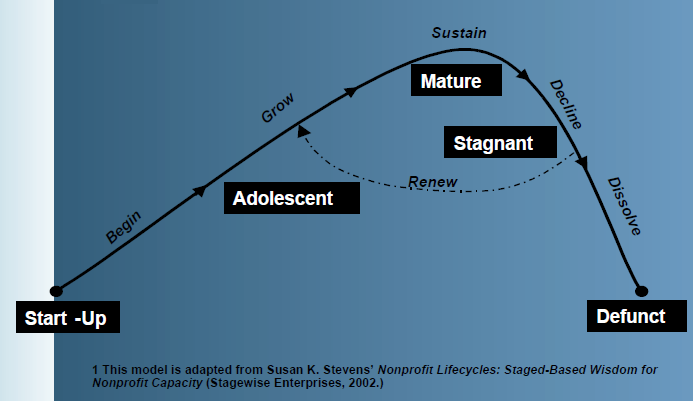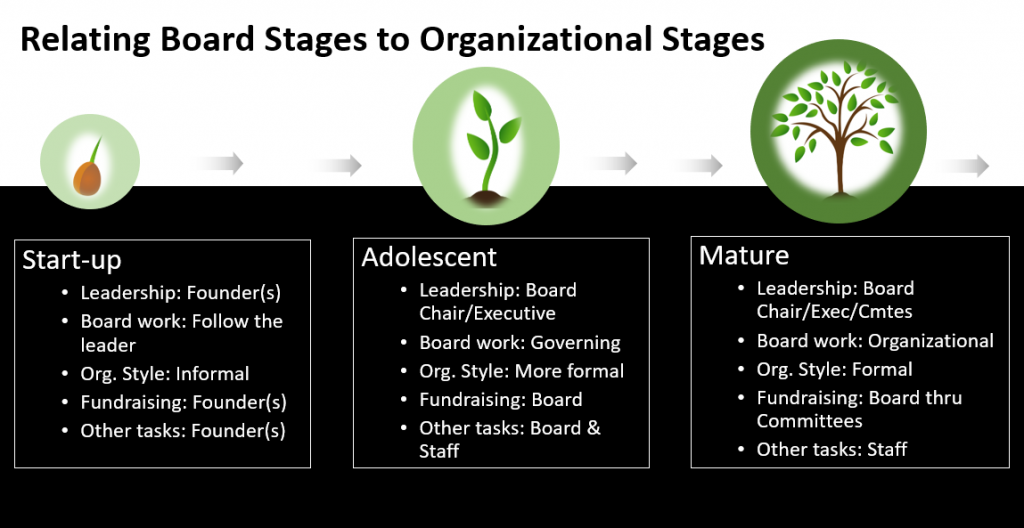July 2019 – Rick Szilagyi, Principal
There is no shortage of articles, and even books, written about the stages in the lifecycle of an organization. I believe the first book I read on the subject was back in the early ‘90s – Corporate Lifecycles by Ichak Adizes. I just Googled and he has a website with a graphic I recall from the book. There is also no shortage of information written about the lifecycle of nonprofit organizations. The New Hampshire Center for Nonprofits opens its page on Organizational Life Cycle Stages by stating that organizations move through stages, just as people do.
What about the lifecycle of the Board of Directors? Surely a board evolves over time, and probably there are relationships between its evolution and that of the organization. What is the relationship to staffing? What is the relationship to finances? Let’s take a look.
The Evolution of the Nonprofit Organization
The stages of the nonprofit lifecycle can be diagramed as shown in the graphic below from The New Hampshire Center for Nonprofits. It shows distinct stages AND that an organization in decline does not have to die. It can reinvent, refocus, etc., and once again become successful:

The Evolution of the Board of Directors
Making the statement that a Board of Directors goes through its own evolution probably does not result in an “OMG moment.” However, digging into the details is very interesting. Please consider reading the article “Board Passages: Three Stages in a Nonprofit Board’s Lifecycle.” The article was written by Karl Mathieson III for BoardSource and can be found here. It reviews how the board evolves from an Organizing/Founding Board, to a Governing Board, and finally to an Institutional Board. Within each stage, the article explores the changes in style, leadership, structure, function, funding and staffing, etc., with an eye on how the tasks and responsibilities of the board evolve.
Relative to “style” it identifies moves from informal to formal. Relative to leadership and leadership structure, it explores the shifts from the founder, to the board, to chair and executive, and finally to having committees responsible for leadership, as well. It explores the shift of responsibilities for funding and reviews how the staff evolves, as well. The area of board responsibilities is very interesting, and once you read it, you realize that it is only through these stages that an organization can grow and become sustainable. We were so taken by the article that we created a chart based largely on some of the text. Let us know if you’d like a copy.
The Evolution of an Organization’s Staffing
It is not rocket-science to realize that if an organization is going to be sustainable, it needs to have staffing, whether this means hiring employees, or working with an association management company. The founder and initial board are not going to be able to do the work forever. Nor will they necessarily have expertise in every area in which expertise is needed. Mathieson’s article discusses the addition of staff in an early stage, and charts some of the challenges. For example, the early board may be resistant to relinquishing certain tasks until confidence is built by the successes of staff.
The Evolution of an Organization’s Funding
There are numerous articles written about how to motivate board members to engage in fundraising. One thing is clear, and it is made clear in Mathieson’s article – board members are NEVER absolved of their responsibility to ensure that the organization has the funding it needs to deliver on its mission. Over the years, Lexian has found that a frequent challenge for start-up and early-stage nonprofits is understanding the importance of fundraising, beyond merely covering today’s expenses. It’s also about providing the fuel to propel the organization to the next stage.
We have already reviewed the evolution of staffing. How can the organization make the move to having a staff, whether it is through an association management company, or through direct hires, without the funding to support it? Mathieson’s article describes how the burden of fundraising shifts from being solely on the founder, to a shared responsibility amongst the board members, and ultimately, refined and managed by committees.
Tying It All Together
Your nonprofit needs to grow through identifiable stages to ensure lasting success. This growth can only happen with a coinciding evolution of the board of directors, and how the board addresses the needs of the organization. Below is an attempt to show how board growth and organizational growth tie-in together.

The Lexian Management newsletter is for informational purposes only.
Always consult your attorney, accountant, and/or insurance provider to obtain advice with respect to any particular issue or concern.
